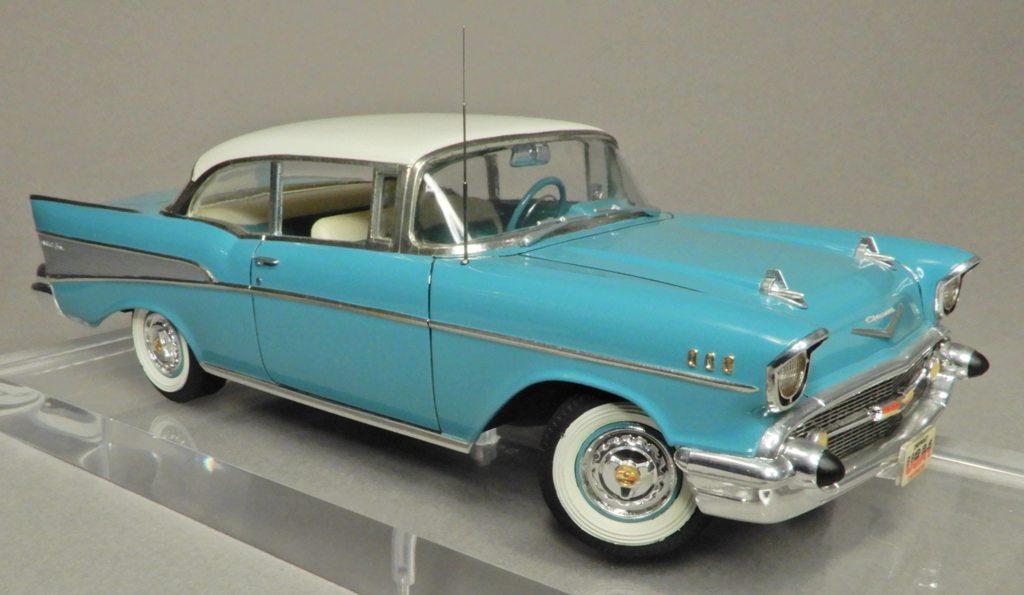-
Posts
9,225 -
Joined
-
Last visited
Content Type
Profiles
Forums
Events
Gallery
Everything posted by peteski
-

Review of Revell's new chrome spray paint
peteski replied to Monty's topic in Model Building Questions and Answers
And what exactly is a difference between ink and paint? I tried to look it up once (on the Interwebs of course) and didn't find any explanation which would satisfy me. Both consist of solvent (the liquid which evaporates), pigment (the colorant), and the binder (the clear stuff where the pigment is dispersed). When the solvent evaporates (dries) the binder hardens up, creating a thin film on the painted surface. -

What was your first model car?
peteski replied to Kit Karson's topic in General Automotive Talk (Trucks and Cars)
Model car? Not a model car kit? Mine was probably some wooden toy dump truck I used sit in its bed and ride around. That was back in Poland. -
Speaking of security cameras, when the HD cameras (and DVRs) can be had for almost nothing, most security camera video shown on the news looks like it was taken with equipment from the 1960s?! Just either unrecognizable dark blobs, or so fuzzy that you can barely see that it is a human. What good is security video when you can't recognize the criminals?
-
Diecast models can also be a kitbashing fodder too. Friend and fellow club member took a diecast truck, kitbashed it with another truck, added lots of detail parts, and repainted it onto a custom wrecker. Here is a link to the photo http://classicplastic.org/image/Maguire-54-Wrecker.jpg No kits (and modeling in general) is not going to suffer just because some pretty decent quality diecast models get thrown into the market.
-
I would have mentioned using Dullcote, but I never envisioned someone wanting to do that to a part which is supposed to depict chromed metal. If one sprays Dullcote over kit's chrome parts, they will look like dull aluminum. Regardless of how weathered 1:1 chrome gets, it never looks like dull aluminum. It might have rust stains and be pitted, but whatever areas still have chrome left, the will still be shiny and reflective. That's just how I see it. You might as well spray the chrome parts with flat aluminum paint.
-
Testors Dullcote is a flat clear that I have used for decades when I need flat finish. Glosscote is the glossy clear lacquer version. Should still be available in spray can and bottles. There are other flat clear finishes available from pretty much every hobby paint manufacturer, both water-based acrylic, and stinky organic-versions.
-
LOL! We have been having this exact discussion in another thread, and here is my proof that disproves that "scale" thing.
-

Removing CA Remover Stains from a windshield
peteski replied to JPolli's topic in Model Building Questions and Answers
CA removers are usually solvents which can attack polystyrene. It has to be "removed" bu mechanical means (sand/polish). -
The subject line and the initial post to me were not very clear. To me "dull" is "satin finish". Later on it was explained that the bright shiny finish on kit's parts was not to Jeff's liking (it was described as unrealistic toy-like). When I build models I strive to make them as realistic as I can (including chrome). I posted my message showing that automotive chrome is by design sparkly and shiny. So much so that even the shiniest model chrome still doesn't look as good as 1:1 chrome. I posted comparison photos as proof. Photos are worth 1000 words. To me it makes no sense to try dulling the kit's chrome. Doing that IMO will make the model look more like a toy than a scale model. So yes, I was trying to convince Jeff to reconsider what he is trying to accomplish. Whether he takes Steve's and my advice is totally up to him.
-

Boeing shoots its own foot once again...
peteski replied to Ace-Garageguy's topic in The Off-Topic Lounge
Whatever it is, it's airborne. At least, due to its size, it has much less wiring than a Dreamliner. -
And there was no 4-hour delivery of your online order (along with tracking). You mailed the order form with a check and waited 4-6 weeks for the kits to arrive. We have it good today!
-
Interesting how closely the Maserati Boomerang resembles Lamborhini Marzal (just more angular). I got curious and found some info about it. https://en.wikipedia.org/wiki/Maserati_Boomerang It actually looks pretty darn slick (and those are weird looking wheels - very '70s SciFi look)! I like it even better than the Marzal.
-
Allrigthy then! That's pretty funny considering . . .
-

Yellow tree from new amt kit
peteski replied to MrMiles's topic in Model Building Questions and Answers
Funny thing is that I have heard or read from multiple sources that no mold release agent is used for injection molding polystyrene. Yes, I have seen some amber "stuff' on some model it parts too, but I wonder if it is just some stray lubricating il from the injection molding machine. It would be interesting to see if the yellow cast can be washed off by scrubbing the parts with soft brush and some warm water and dishwashing detergent. -
Why keep another thread going when there is a thread on this subject currently active? Yes, even the apparently steep price has been mentioned there.
-
I also don't understand this quest to dull model kit's chrome (actually aluminum applied using vacuum metalizing process), because it looks "toyish". Polished chrome is chrome, regardless of scale. Maybe some of you just don't carefully observe the 1:1 scale world around you? Here's an example of 1:1 chrome. And one of my models with chrome parts: Why in the world would I want to make my model's chrome duller than what it looks like now? If anything, I wish it was even more "sparkly" and shiny. And a car example. Here is a 1:1 chromed bumper: Any my model of a similar car: Again, if anything, I wish my model's chrome was even shinier, brighter, and more reflective. In both examples, it was the original kit's chrome. Chrome is one of the things on a 1:1 car that stays shiny after the rest of the car rusts away. Even on junkers, the chrome stays shiny (although it might look a bit duller due to dirt and dust that covers it after a while). I just don't get it.
-

1/24 Cobra 289 FIA / USRRC wheels
peteski replied to Hoffman's topic in Car Aftermarket / Resin / 3D Printed
I think that is a very good idea Jason. There are already some topics like that where members request certain 3D parts to be made by certain individuals who produce 3D parts. This way we all can publicly recommend or request certain items we would like to see produced. -
Not for profit doctors?! Where you find them (and who accept insurance) in USA? Medical field is a huge for-profit system. And doctors, just like with other professions: car mechanics, construction, workers, dentists, computer techs., house painters, gardeners (and every other profession or trade), there are good and not so good people out there. It stinks, but that's the reality. Yes, it would be good idea to try another doctor, hoping that they will be better as the old one.
-

Some crazy bidding on MPC One Arm Bandit!
peteski replied to peteski's topic in General Automotive Talk (Trucks and Cars)
Yup, I did see this one. It has couple small parts missing, and of course bad decal. We'll see how high the bidding goes. Good luck! -
I remember Kraco, but at that time in my '76 Camaro I had a Vector Research radio/cassette player and a 40W Sparkomatic booster/equalizer with Pioneer speakers in the doors and the package deck. I think the front ones were 2-way 6" speakers, and the rear ones were 3-way 6X9s. I didn't live in a good neighborhood, so the radio was mounted in a Bensi box (remember those?). It made the radio removable, so I could take it with me. This was before removable faceplates became a thing. I also made a removable cover for the equalizer, so it wasn't visible. I think we are getting off the original subject here.
-

Bob Smith Industries Glue
peteski replied to WizPorsche944's topic in Model Building Questions and Answers
BSI CA adhesives (and accelerator) are my go-to CAs for model building. I pretty much have all viscosity, and odorless too. I decide on which one to use depending on the task at hand. But I have to admit that I'm addicted to the super-thin variety (with accelerator). I want my glue joints to set fast! Some hobby shops re-brand those as their own brand (but it is still BSI). Here the accelerator was re-branded for a local shop (long since closed).





